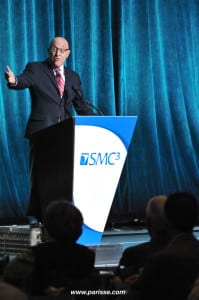What is the #1 best way to present from behind the lectern? Take a half-step back. One that is wide enough to put some distance between the lectern and you, yet close enough to maintain visual contact with your notes and vocal contact with the microphone, unless you are wearing one.
Since we intuitively knew to step back from the lectern, Lisa and I thought this was an inconsequential piece of knowledge everyone knew. Then came a series of wholesaler trainings for a large global financial services firm. They came to us a coaches’ dream team: strong, well-trained presenters who wanted to get even better. Yet something seemed to fall apart when the lectern was introduced. As Lisa was working with their choreography behind the lectern, one of our participants shouted out “take a half-step back”. SHAZAAM! It all became clear … and it works.
Taking a half-step back is absolutely the #1 best way to present from behind a lectern because it gives you the best of both worlds: the credibility that can come from being behind the lectern and having room to gesture and move.
Two Common Pitfalls of Presenting Behind a Lectern:
- The Crutch: Lecterns are often used as a place for nervous speakers to hide. In The Speaking Intensive presenter development program, we work to bring speakers out from behind the lectern so they gain the comfort and experience necessary to have a choice about when to most effectively in front of a room.
- The Hate: “I never go behind the lectern. I hate them.” Ok, but what will you do if there is no choice and you are stuck behind one? How about if the situation is sufficiently grave or consequential that you need a place to put your detailed notes or a script?
3 Mistakes Lectern Presenters Make:
Stepping back will also help cure common mistakes presenters make behind a lectern.
- The Hug: If you’ve ever witnessed “the hug”, then you know what I’m talking about. The presenter’s arms placed on either side of the lectern, elbows out, as if latching on to a long lost friend. Huggers appear hunched over, somehow weakened.
- The Death Grip: Is a description really necessary here? Gripping the lectern until your knuckles turn white is not compelling to an audience. If the audience isn’t engaged, the sweaty imprint of your hand is all that will be left as evidence you were ever there.
- Dancing Feet: Speaking is a full body sport. That’s obviously true when you are standing clear of the lectern, and it is also true behind a lectern. A sloppy stance will sap your credibility even when the audience can’t see your lower body. They will sense something is not quite right, but won’t know why.
Each of these correctable conditions chips away at your credibility and can cause the audience to disconnect. No matter how compelling your presentation may be, audiences won’t fully buy-in if your body doesn’t support your message.
A “SHORT” NOTE:
If you are as short as I am, find something to stand on. I’ve used a milk crate (shaky), a commercial dishwasher glass rack (more stable – but not suitable for some shoes) and anything else I could find. You want to see the audience and for them to see you. You certainly don’t want them wondering where that voice is coming from.
Sure, lecterns are kind of old school, but they add an aura of authority to you and your message and can even be an effective tool when used correctly. Presenters who learn how to leverage the lectern increase their range of audience connection.
Join us at The Speaking Intensive. Presenters from The Chicago Bulls, Merrill Lynch, JP Morgan, Allianz, LPL, Rockwell Collins and 40 other firms already have. Now it’s your turn. Just 1 seat left in the August session. Catch the early registration discount for the October session!
Client Raves:
“Transformational. A professional breakthrough.”
“Fantastic!! Ultimately a straight route to improve my impact and influence.”
“As much a Leadership Development experience as a Public Speaking course.”
“Thank you for pushing me to tap into “tools” I didn’t know I had.”
“Definitely the best program I’ve ever attended.”
 Hall of Fame speaker Alan Parisse has been coaching presenters and delivering keynotes for over 25 years. Named “One of the Top 21 Speakers for the 21st Century” by Successful Meetings Magazine, he is a keynote speaker for a wide variety of industries and organizations. Alan is a passionate presentation coach to executives, financial advisors, sports stars and sales presenters.
Hall of Fame speaker Alan Parisse has been coaching presenters and delivering keynotes for over 25 years. Named “One of the Top 21 Speakers for the 21st Century” by Successful Meetings Magazine, he is a keynote speaker for a wide variety of industries and organizations. Alan is a passionate presentation coach to executives, financial advisors, sports stars and sales presenters.
Lisa Casden has been coaching presenters for 10 years. A former professional figure skater, coach and choreographer, Lisa leverages her unique background and point of view to help speakers organize their physicality in ways that best support their message.
has been coaching presenters for 10 years. A former professional figure skater, coach and choreographer, Lisa leverages her unique background and point of view to help speakers organize their physicality in ways that best support their message.


 Keynote Topics
Keynote Topics About Alan Parisse
About Alan Parisse Why Hire Alan?
Why Hire Alan? Client Testimonials
Client Testimonials Booking Request Form
Booking Request Form